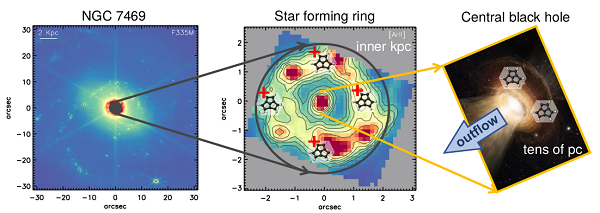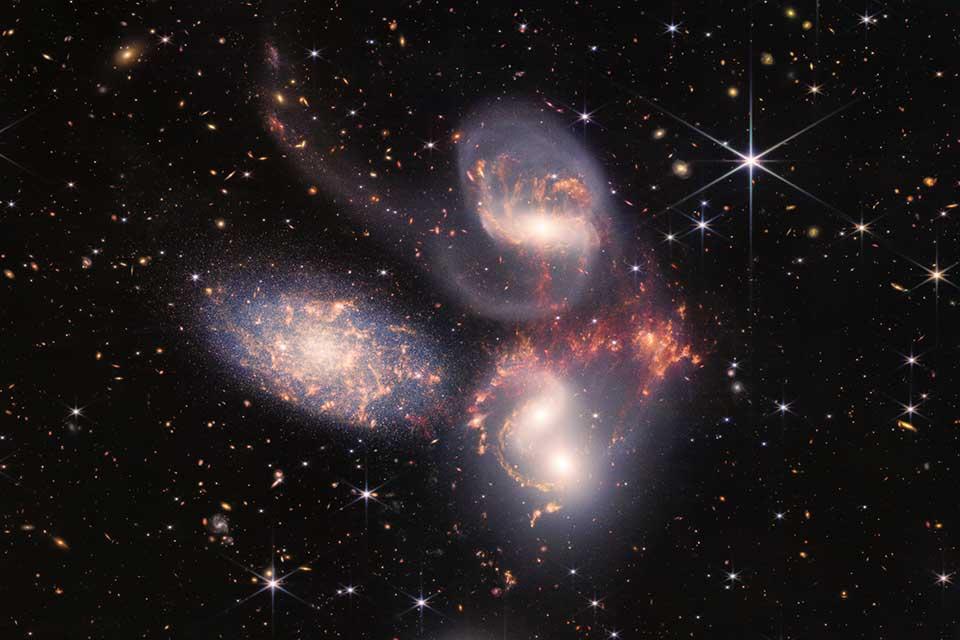Research led by Dr Ismael García-Bernete from the University of Oxford is the first of its kind to study tiny dust molecules known as polycyclic aromatic hydrocarbons (PAHs) in the nuclear region of active galaxies using early observations from the James Webb Space Telescope. The study is the first UK-led paper utilising spectroscopic data from the James Webb Space Telescope’s Mid-Infrared Instrument, MIRI. The work addresses one of the biggest challenges in modern astrophysics: understanding how galaxies form and evolve.
All-seeing infrared
Observing PAH molecules in the innermost regions of the galaxy is one of the best ways to study the influence of the central black hole in the evolution of the host galaxy where classical diagnostic tools – mainly in the visible range – have their limitations. This is because the dense clouds of gas and dust in the hearts of active galaxies absorb a large fraction of visible light and so obscure activity. Infrared light however is practically unaffected by dust and so allows a much clearer view behind thick curtains of dust.
‘The JWST MIRI provides us with a fantastic opportunity to observe galaxies in a way that just hasn’t been possible up until now,’ explains Dr García-Bernete. ‘PAH molecules are of particular interest as, abundant in space, they are among the most widespread organic molecules in the Universe. They are considered important building blocks of prebiotic compounds, which could play a key role to the origin of life. In addition, PAHs are also important astronomical tools. They produce extremely bright emission bands in the infrared, when they are illuminated by stars, enabling astronomers to trace not only the star-formation activity but also use them as sensitive barometers of the local physical conditions in the interstellar medium.’
Cutting-edge instruments
The group, led by Professor Dimitra Rigopoulou, used JWST’s cutting-edge instruments to characterise, for the first time, the PAH properties in the nuclear region of three luminous active galaxies. To do so, they compared the observations with theoretical predictions for these molecules. The PAH models were developed by the group, in a joint effort with the Physical Chemistry group at the University of Oxford in work funded by the University of Oxford's Fell Fund.
Where previous work predicted the destruction of the PAH molecules in active galaxies, Dr García-Bernete’s study reveals that somewhat surprisingly, PAH molecules can actually survive in the vicinity of the black hole – even where very energetic photons could potentially rip them apart. One reason that could explain this could be that the molecules are protected by large amounts of molecular gas in the nuclear region.
Acquiring reliable knowledge
‘We were excited to find that PAH molecules can actually survive even in these extremely harsh conditions,’ continues Dr García-Bernete. ‘This research is of great interest to the wider astronomy community, particularly those focused on the formation of planets and stars in the most distant and faint galaxies. Acquiring reliable knowledge about PAH molecules is key, especially for environments extremely rich in gas and dust where traditional diagnostics usually fail due to the high obscuration present.’

However, even where PAH molecules survived, the results showed that the supermassive black holes at the heart of galaxies had a significant impact on their properties. In particular, the proportion of larger and neutral molecules became greater, indicating that more fragile small and charged PAH molecules may have been destroyed. This brings severe limitations to using these PAH molecules to probe how rapidly an active galaxy makes new stars.
Next steps
‘It is incredible to think that we can observe PAH molecules in the nuclear region of a galaxy and the next step is to look at more active galaxies with different properties,’ concludes Dr Garcia-Bernete. ‘This will enable us to obtain statistically significant results for the overall population of active galaxies to better understand how the survival of the PAH molecules depends on the properties of the central monster.'
A high angular resolution view of the PAH emission in Seyfert galaxies using JWST/MRS data, García-Bernete et al, Astronomy and Astrophysics, October 2022
See also:
https://www.physics.ox.ac.uk/news/commentary-professor-bunker-james-webb-space-telescope
https://www.physics.ox.ac.uk/news/probing-active-galactic-nuclei-polycyclic-aromatic-hydrocarbons
Galactic Activity, Torus and Outflow Survey international collaboration GATOS

